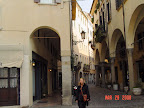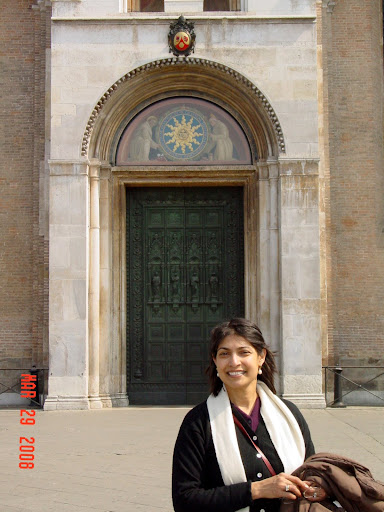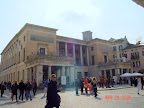Pilgrimage to Padua
(In front of the main entrance to the Basilica of St. Anthony of Padua, in Padua, Italy)
Our final port of call in Italy was Padua, the small medieval city that is best known for three things: The famous Basilica of St. Anthony of Padua that has attracted pilgrims for centuries from all over the world, the Capella Arena which hides a fresco cycle by the medieval artist Giotto and the buildings of the University of Padua, the second oldest in the country (younger only than the one at Bologna) where Galileo was once a professor. What we loved in addition to all these attractions was the medieval quarter of the city which has been preserved so perfectly that the winding labyrinth of streets seemed to have been frozen completely in time. As we walked down the cobbled streets, we could have sworn we might have bumped into Galileo on his way to the university!
We took the morning train from Venice’s Santa Lucia Station to arrive about 45 minutes later in Padua. Once outside the station, we tried to find the Double Decker Hop-On, Hop-Off Sight-seeing bus but with our limited Italian and no one knowledgeable enough to tell us where to go to hop into it, we were left to our own resources. At the public bus ticket booth, the clerk advised us to buy a ticket to get to the Basilica of St. Anthony but only after we had visited the Capella Arena. That, he assured us, was a short walk away, no more than ten minutes.
Not quite sure we had understood him, we took his advice anyway, and ten minutes later, we arrived at the beautiful public gardens in which the tiny Capella Arena is set (left). Part of the complex of the archeological museum that houses excavated finds that date back to Roman times, we needed to buy a ticket inside the museum. At the counter, we held our breath, literally, for we had been informed only the previous day that entry into the chapel is strictly regulated. No more than 30 people are allowed in for visits lasting no more than 15 minutes. Since the time of one’s entry into the chapel is inscribed on the ticket, we felt fortunate to receive the last two tickets for the day, for a tour that began at 1. 30 pm.
With about two hours to kill before our chapel visit, we took a tram (our first tram ride in Europe on this trip) from the Piazza Ermitiani, opposite the museum complex and arrived at the Piazza in which the Basilica of St. Anthony is located (left). I was very excited about visiting this church. As a practicing Roman Catholic, I am aware that this church is a very important center of pilgrimage. In India, where I was raised, devotion to St. Anthony of Padua is very strong and I had seen pictures of this saint since my childhood. I was delighted to visit the place of his birth and to see the Basilica that announces so many miracles on its walls.
 Nothing, however, had prepared me for the grandiose dimensions of this church (left). Indeed, it is huge and very exotic, characterized by Byzantine domes and minaret-like spires. Built in 1232 of stark red brick to house the mortal remains of St. Anthony, it rises like a sentinel, quite awesome in its size and splendor. Once inside, one is overwhelmed by the wealth of visual details. There is a succession of chapels or altars, each dedicated to a different saint. Baroque in its conception and design, the basilica boasts so much fine sculpture and art work on its walls, not to mention a splendid cycle of frescoes in the St. James Chapel that have been recently restored and are stunning in their impact. In a small Benediction chapel, a priest was available to grant blessings upon the faithful.
Nothing, however, had prepared me for the grandiose dimensions of this church (left). Indeed, it is huge and very exotic, characterized by Byzantine domes and minaret-like spires. Built in 1232 of stark red brick to house the mortal remains of St. Anthony, it rises like a sentinel, quite awesome in its size and splendor. Once inside, one is overwhelmed by the wealth of visual details. There is a succession of chapels or altars, each dedicated to a different saint. Baroque in its conception and design, the basilica boasts so much fine sculpture and art work on its walls, not to mention a splendid cycle of frescoes in the St. James Chapel that have been recently restored and are stunning in their impact. In a small Benediction chapel, a priest was available to grant blessings upon the faithful.
Relics of St. Anthony:
The most valuable sculpture adorning the main altar inside the basilica is by Donatello. Behind the main altar is concealed the crypt that contains a visually stunning chapel dedicated entirely to the relics of St. Anthony. In this holy shrine is kept intact the brown cassock and rope belt that the saint wore as part of the Franciscan order to which he belonged. There are also his bones preserved in fabulously crafted receptacles that decorated the altar. Priests were available to grant blessings and distribute a few mementos of one’s visit.
Out in the main basilica once again, we saw the grand tomb of St. Anthony surrounded by portrayals of his cycle of life depicted through marble bas relief sculptures that were finely carved. Flanked on either side by 18th century Baroque candle stands, this chapel is one of the most frequently visited inside the church.
Outside in the church piazza, we picked up memorabilia of our own visit from a kiosk close to the equestrian statue by Donatello of Gatamelata. Then, we boarded the tram that took us back to Piazza Ermitiani. Picking up sandwiches and a bottle of water from a near-by deli, we sat in the public garden, already filled with daffodils, to enjoy the sunshine and our lunch before we made our way to the Capella Arena for our 1.30 appointment.
The Amazing Capella Arena:
Featuring in Marina Vaizey’s 100 Masterpieces of Art is The Lamentation over the Dead Christ which is part of the Capella Arena that was built in 1303 by Enrico Scrovegni in an attempt to spare his dead father, a usurer by profession, from the tortures of Hell as described by Dante in his Inferno. The Florentine artist Giotto was commissioned to decorated the small chapel from floor to ceiling. Regarded as the Father of Western Art, he straddles the divide between Medievalism on the one hand and the Renaissance on the other. His work was extremely influential especially in his depiction of space and perspective. It is impossible that one man could have painted the entire sequence of frescoes in just two years. Indeed it is very likely that the work was carried out with the aid of several assistants though Giotto was undoubtedly their author.
Given that we had only 15 minutes in which to take in the entire wonder of this work, I was confused, not knowing exactly where to look and what to scrutinize. Finally, after my eyes had passed over the interior, I paused in front of The Lamentation and used my notes to study it. The entire west wall of the chapel is covered with Giotto’s depiction of The Last Judgment while the sides portray scenes from the Life of Christ and the Life of Mary. There are also allegorical portrayals of the Vices and Virtues filling negative space. Overall, the impact of this room was just spectacular and, before we knew it, our 15 minutes were up, a whistle was blown and we were asked to leave. Out in the sunshine once again, we realized that there was a wealth of archeological material to be explored but with time going against us, we elected instead to take a walking tour of the historic center of Padua which also contained the beautiful historical buildings of the University of Padua.
Padua’s Historic Center:
With the aid of a map, we followed the route that led us to Piazza Cavour which is the beginning of the historic district. A bronze statue of a woman by Emilio Greco guards the square that was full of visitors that morning. Just a few meters ahead on the same street, is the famous Café Pedrocchi ( above left) which has been a meeting place for students and intellectuals from the university since 1831. Built in the style of a classical temple, we did pay it a lightning visit with an eye to exploring the interior that is filled with some interesting frescoes.
 Then, we were out in the maze of narrow, cobbled streets that housed smaller eateries (left). Passing by the Law School of the University, we arrived at Piazza Delle Erbe in which a farmer’s market was located. Fresh fruit and vegetables were filling the shopping bags of Padua’s housewives even as our eyes roamed over the ornately frescoed interior of the Palazzo della Ragione that stood in the square covered with wonderful painterly decoration. These hidden nooks and crannies of the city were entirely charming and we wished we could have spent more time just rambling aimlessly through these historic pathways.
Then, we were out in the maze of narrow, cobbled streets that housed smaller eateries (left). Passing by the Law School of the University, we arrived at Piazza Delle Erbe in which a farmer’s market was located. Fresh fruit and vegetables were filling the shopping bags of Padua’s housewives even as our eyes roamed over the ornately frescoed interior of the Palazzo della Ragione that stood in the square covered with wonderful painterly decoration. These hidden nooks and crannies of the city were entirely charming and we wished we could have spent more time just rambling aimlessly through these historic pathways.
 But with an urgent desire to spend our last evening in Venice, we took the train back to Santa Lucia Station, very pleased that our day trip to Padua had been such a success. We spent our last evening in Venice sampling the wonderful gelato at Gelateria Nico at San Zaccaria about which all the guidebooks rave. And quite deservedly too for it was among the best gelato we ate in Italy.
But with an urgent desire to spend our last evening in Venice, we took the train back to Santa Lucia Station, very pleased that our day trip to Padua had been such a success. We spent our last evening in Venice sampling the wonderful gelato at Gelateria Nico at San Zaccaria about which all the guidebooks rave. And quite deservedly too for it was among the best gelato we ate in Italy.
Return Home:
The next morning, we set our clocks for our early departure from Venice to London from Treviso airport. How shocked we were to discover that we had lost an hour during the night due to daylight savings time of which we had no clue! Unable to retrieve that lost hour, we had no choice but to take a taxi to the airport instead of the bus we had intended from Piazza La Roma. To cut a long story short, we did get our flight and discovered in the check-in queue that almost everyone had made their way to the airport by cab that morning having no knowledge about the changing of the clocks. Our Ryan Air flight took off on schedule, we arrived at London’s Stansted airport earlier than expected and hopping on to the Easybus, we got to Victoria in an hour and a half.
 There, I had the most wonderful reunion with four of my high school classmates –Bina, Chandra and Rosita who had arrived from Melbourne, Australia (left).
There, I had the most wonderful reunion with four of my high school classmates –Bina, Chandra and Rosita who had arrived from Melbourne, Australia (left).
Needless to say, it was great fun especially as the weather in London was just delightful with wonderfully bright sunshine and clear blue skies. Amy and I enjoyed the long drive by Easybus from Stansted airport to Victoria where we saw the fresh spring greenness of miles of fields, the neat suburban row houses with their sprucely-tended handkerchief sized gardens and the stately grand mansions and monuments of Central London.
That morning, Amy and I had taken the Tube to check out the village of Islington which, in recent times, has become very hip indeed.
Then, by 5. 30 pm. it was time for me to bid goodbye to my classmates and return on the Tube to Heathrow from where we boarded our American Airlines flight back to the US after what had been a truly memorable trip indeed.
Thanks for armchair-traveling with Amy and me on this incredible tour of Italy. I do hope that I have managed to convey some of the thrills and wonders of the sights we beheld and the experiences we encountered.
Do continue to travel to other parts of the world with me. A dazzling array of destinations are only a click away.
Bon Voyage!



